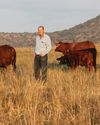Prøve GULL - Gratis
The Do's And Don'ts Of Tail Docking
Stockfarm
|December 2020
Tail docking is usually performed in sheep and involves both surgical and non-surgical methods to shorten or remove the tail.

While some people may feel discomfort or squirm at the thought, many producers routinely dock a lamb’s tail when it is only a few days old.
Tail docking in sheep is based on the following principles:
• In fat-tailed sheep breeds, tails are docked to prevent fat from accumulating in the tail.
• In wool breeds, faeces and urine that soil the tail is blamed for blowfly strike.
• There is a perception that ewes with long tails may not be mated successfully.
According to Dr Johan van Rooyen, veterinary specialist practitioner for small stock at Steynsburg Animal Hospital, these reasons for tail docking lack some credibility. “There is very little evidence to support the statement that cutting tails improves the health of non-wool breeds. In addition, the benefits in terms of conception rate and prevention of blowfly strike in wool breeds are not always clear. In my opinion the main reason for tail docking adds up to aesthetic reasons and peer pressure from those who believe that sheep with tails will resemble a slapdash or careless way of farming.”
Tail docking is not mandatory, and many producers are no longer docking their lambs’ tails. “It is worth noting that tail docking is perceived as a potential hazard by animal rights groups who are targeting all procedures on animals that could be painful or dangerous,” says Dr Van Rooyen. “However, if it is performed, it should be done as professionally as possible.”
Denne historien er fra December 2020-utgaven av Stockfarm.
Abonner på Magzter GOLD for å få tilgang til tusenvis av kuraterte premiumhistorier og over 9000 magasiner og aviser.
Allerede abonnent? Logg på
FLERE HISTORIER FRA Stockfarm

Stockfarm
Ecovite Drifos P12 and P6: Weather resistant phosphate supplements
Over 90% of South African soils are deficient in the mineral phosphorus. The country's warm, dry climate contributes to low levels of organic matter, which in turn limits phosphorus availability to animals.
4 mins
October 2025
Stockfarm
Tick resistance raises concerns
Ticks are the cause of significant annual economic losses, primarily because of the diseases they transmit. In South Africa, the blue tick species is the main culprit.
3 mins
October 2025
Stockfarm
The next generation herd health plan
<span class=
2 mins
October 2025

Stockfarm
When FMD hits: Protocols and practices
South Africa's cattle sector faces tremendous challenges regarding biosecurity and traceability. This year, the dairy industry was among the hardest hit by foot-and-mouth (FMD) disease outbreaks in most provinces in the country, especially the Eastern Cape.
10 mins
October 2025

Stockfarm
Back to basics: Success is built on simplicity and order
We live in an age of constant noise in which we are flooded daily with information and endless decisions.
7 mins
October 2025

Stockfarm
Grassland Society presents 60th congress
The 60th Congress of the Grassland Society of Southern Africa (GSSA) was recently held in Hilton, KwaZulu-Natal, drawing around 160 delegates from across Southern Africa.
3 mins
October 2025

Stockfarm
Livestock's water requirements in intensive and extensive production systems
The Earth's total water supply is estimated at around 1 386 million km³. However, only 2,5% of this comprises freshwater. Of that small fraction, approximately 68,7% is locked away in ice and snow formations in Antarctica, the Arctic, and mountainous regions.
4 mins
October 2025
Stockfarm
Breeding values level the playing field
The production of a dairy cow is influenced by factors such as age, calving season, lactation number and stage, pregnancy status, length of her previous intercalving period (ICP), nutrition, temperature, and management.
3 mins
October 2025

Stockfarm
Boost spring pastures with effective fertilisation
Applying the right nutrients to planted pastures that are tailored to the specific plant species and local environmental conditions, can significantly boost both yield and quality. However, given the high cost of fertilisers, they must be used efficiently to ensure pastures are optimally utilised by livestock. Renier Bothma, a soil scientist at Kynoch Fertilizers, explains that rainfall is a key factor in pasture production under dryland conditions. The more it rains, the greater the pasture growth and the higher the nutrient demand for maintaining optimal yield and quality.
3 mins
October 2025

Stockfarm
WHAT'S UP?
Theft burdens agricultural growth
6 mins
October 2025
Translate
Change font size
